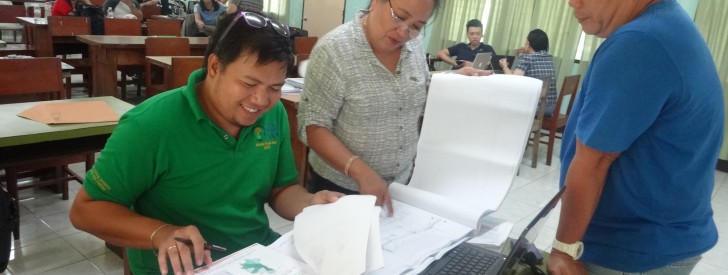 PRDP PSO South Luzon I-BUILD Component Head Engr. Allan Tatierra and RPCO V I-BUILD Rural Infrastructure Engineer Zosimo D. Ordas Jr. assist Engr. Lony Basilio of PPMIU-Virac, Catanduanes. Tatierra and his team from the PSO are in Bicol for a Joint PSO-RPCO-PPMIU Technical Review of I-BUILD SPs following a series of site validation conducted on September 2-4, 2015 as part of the PRDP’s Infrastructure Quality Monitoring and Durability System (IQMDS).
PRDP PSO South Luzon I-BUILD Component Head Engr. Allan Tatierra and RPCO V I-BUILD Rural Infrastructure Engineer Zosimo D. Ordas Jr. assist Engr. Lony Basilio of PPMIU-Virac, Catanduanes. Tatierra and his team from the PSO are in Bicol for a Joint PSO-RPCO-PPMIU Technical Review of I-BUILD SPs following a series of site validation conducted on September 2-4, 2015 as part of the PRDP’s Infrastructure Quality Monitoring and Durability System (IQMDS). Follow I-BUILD specs to the letter to achieve world-class FMRs under PRDP-PSO South Luzon I-BUILD Head
September 10, 2015
“Follow the specs to the letter.” This is the reminder of Philippine Rural Development Project (PRDP) Project Support Office (PSO) South Luzon Intensified Building up of Infrastructure and Logistics for Development (I-BUILD) Component Head Engr. Allan C. Tatierra to the Construction Supervision Team after conducting a series of site validations to on-going infrastructure development sub-projects (SPs) in Bicol.
According to Tatierra, strict implementation of plans and specifications by the National Project Coordination Office (NPCO), PSO, Regional Project Coordination Office (RPCO), the City/Municipal/Provincial Project Management and Implementation Unit (C/M/PPMIUs), and contractors are necessary to guarantee world-class quality farm-to-market roads (FMRs).
“The challenge lies in implementing the specifications (based on our findings),” said Tatierra.
Under the PRDP, FMR projects are expected to have world-class quality through Portland Cement Concrete Pavement (PCCP), minimum of five meters for two lanes, minimum of six inches thickness, and shoulders with a minimum of 1.5 meters and gravel surfacing.
In addition, PRDP-approved projects are designed to have 1.5% cross slope for PCCP and 3% for gravel surfacing (shoulder), minimum of 30 meters radius of horizontal curve, minimum of 30 meters length of tangent between reverse curve, minimum of 60 meters length of vertical curve, design speed of 30 kilometers per hour for all terrain, road drainage consists of box culvert designed for 25-year flood with sufficient freeboard to contain 50-year flood and pipe culvert designed for 15-year flood with sufficient freeboard to contain 25-year flood with a minimum pipe size of 910 millimeter in diameter.
Initial findings of the PSO and RPCO V reveal that materials used and specifications of some on-going sub-projects in the region were not followed. Tatierra cautioned that failure to religiously adhere with PRDP and World Bank standards might result to remove-and-replace orders or worse, cancellation of the SP.
“May masasayang na pera, time, and efforts. Sayang ang opportunity para magkaroon ng magandang project (Money, time, and efforts will be for naught. An opportunity for a good project will be missed),” he said.
To address this issue, Tatierra calls for application of infrastructure development trainings conducted and reforming old school misconceptions.
“Kailangan nang baguhin yung impression na kapag government project, puwede nang hindi sundin yung standard. Ngayon, sa PRDP mino-monitor na sila gamit ang makabagong technology (Now is the time to change the impression that it is alright to deviate from standards if it is a government-implemented project. With PRDP, modern technology is being used to monitor them),” he underscored. He added that project conceptualization and implementation be undertaken by competent technical staff.
PRDP’s context of quality requires adhering to an agreed minimum quality assurance indicators to be adopted through an Infrastructure Quality Monitoring and Durability System (IQMDS), which sets the minimum key quality assurance indicators, quality control and monitoring processes to ensure durability of infrastructure SP. These include Management Support System, Contract Review, Inspection and Testing, Document Control, and Operation and Maintenance.
The Project uses an information and communications technology (ICT) application called Applied Geotagging Tool as a transparency measure in which digital resource like photos, website, and text message are associated with a physical location. Geotagged photos are being mapped into Google Earth, showing the precise location of the SP. AGT is also integrated in PRDP’s procurement system as it requires geotagged photos of SPs’ physical accomplishments and deliveries of goods for the progress billings and requests for payment of contractors.
Tatierra and the PSO I-BUILD team are in Bicol on September 7-10, 2015 for a Joint PSO-RPCO-PPMIU Technical Review of I-BUILD SPs following the site validation wherein nine sub-projects from the six provinces of Bicol as well as the Municipalities of Virac, Catanduanes, Placer and Esperanza in Masbate are being reviewed and refined for possible No Objection Letter 1 issuance from the NPCO by October 2015.
Per PRDP PSO South Luzon Director Shandy M. Hubilla’s report during the PRDP 1st Implementation Support Mission in Puerto Princesa, Palawan on August 26, 2015, Bicol has the largest share of I-BUILD SPs in the cluster with 14 approved infrastructure development sub-projects worth P1,116.18 billion.
PRDP is a six-year Project worth P27,483.95 billion composed of financing from the World Bank loan of P20.50 billion, Global Environment Facility (GEF) grant of P287 million, National Government of P3.579 billion and Local Government Units (LGUs) equity of P3.118 billion. It aims to raise annual real farm incomes of household beneficiaries by 5%, increase the value of annual marketed output by 7%, and increase the number of farmers and fishers with improved access to Department of Agriculture’s services by 20% through an inclusive, market-oriented, and climate-resilient agri-fishery sector nationwide. (Annielyn L. Baleza,I-SUPPORT InfoACE Unit, DA-RAFIS 5)
